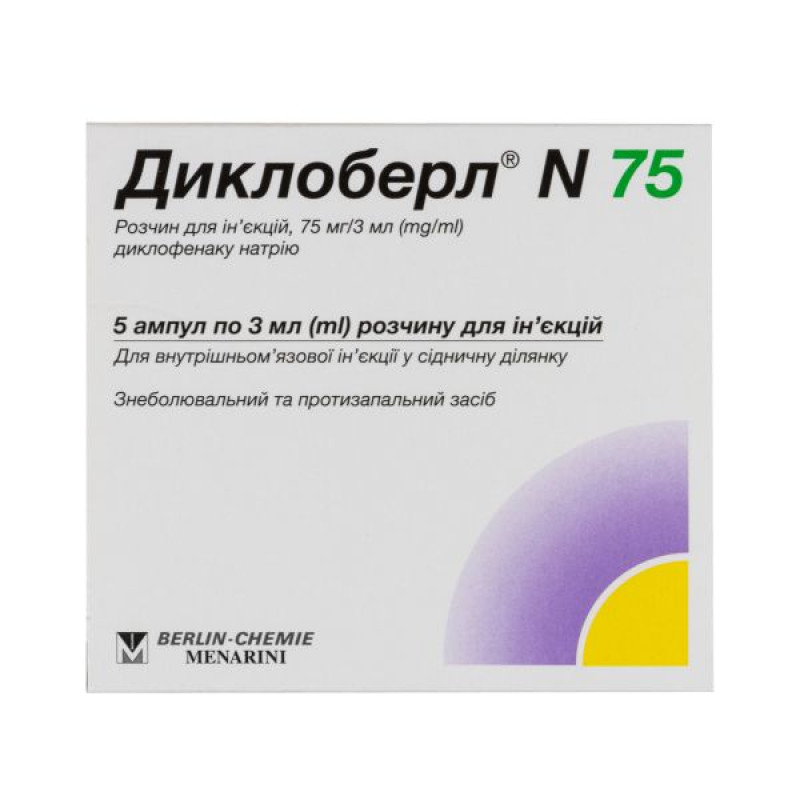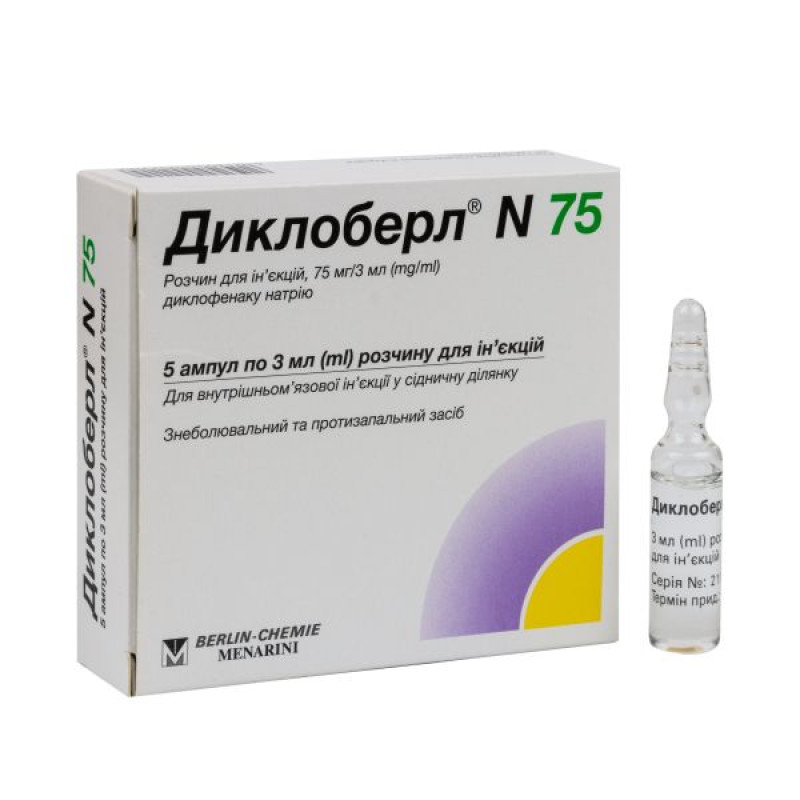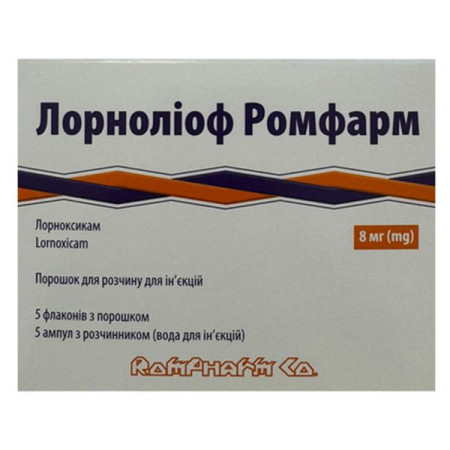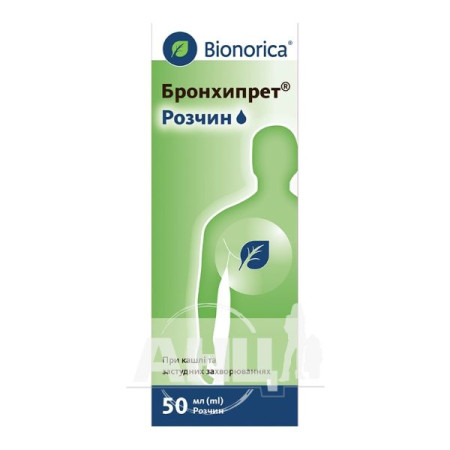Dicloberl N 75 solution for injection 75 mg ampoule 3 ml No. 5
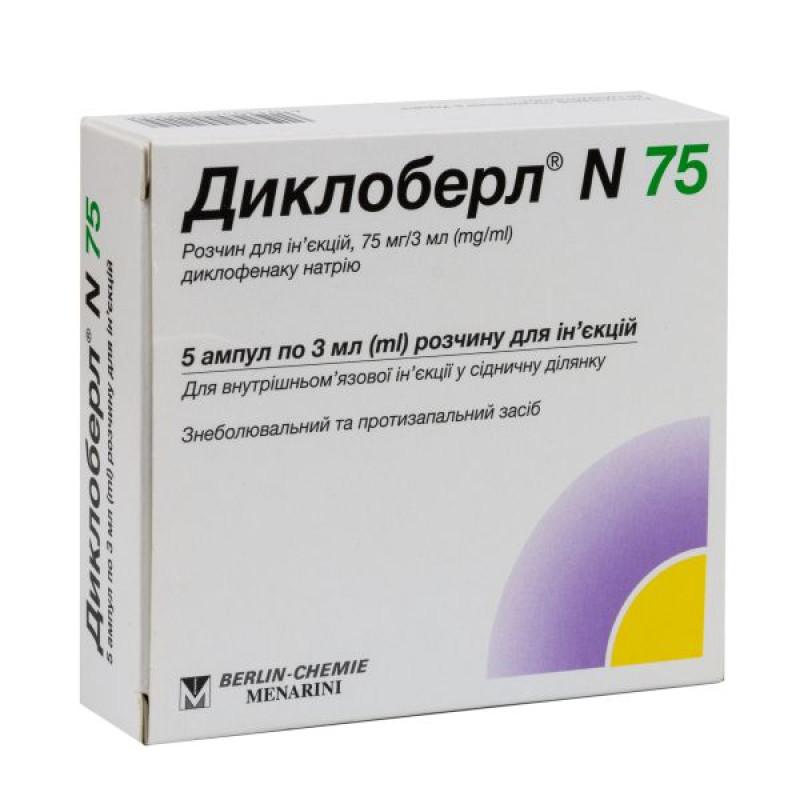
Instructions Dicloberl N 75 solution for injection 75 mg ampoule 3 ml No. 5
Composition
active ingredient: diclofenac sodium;
1 ml of solution for injection contains 25 mg of diclofenac sodium (1 ampoule contains 3 ml of solution for injection, which is equal to 75 mg of diclofenac sodium);
Excipients: propylene glycol, benzyl alcohol, acetylcysteine, mannitol (E 421), sodium hydroxide, water for injections.
Dosage form
Solution for injection.
Main physicochemical properties: transparent solution from colorless to almost colorless, does not contain visible particles.
Pharmacotherapeutic group
Nonsteroidal anti-inflammatory and antirheumatic drugs. Acetic acid derivatives and related compounds. ATX code M01A B05.
Pharmacological properties
Pharmacodynamics.
Dicloberl N75 is a nonsteroidal drug with pronounced analgesic/anti-inflammatory properties. It is an inhibitor of prostaglandin synthetase (cyclooxygenase). Diclofenac sodium in vitro at concentrations equivalent to those achieved in humans does not inhibit the biosynthesis of proteoglycans in cartilage tissue. When used concomitantly with opioids for postoperative pain relief, Dicloberl N75 often reduces the need for opioids.
Pharmacokinetics.
Absorption.
After administration of 75 mg diclofenac by intramuscular injection, absorption begins immediately and the mean maximum plasma concentration of approximately 2.558 ± 0.968 μg/ml (2.5 μg/ml is approximately 8 μmol/l) is reached after 20 minutes. The extent of absorption is linearly proportional to the dose.
In contrast to the corresponding results for oral administration, when the drug is administered as a suppository or intramuscularly, the plasma concentration decreases rapidly once peak levels are reached.
Bioavailability.
The area under the concentration curve (AUC) after intramuscular or intravenous administration is approximately twice as large as after oral or rectal administration, because this route allows for the avoidance of first-pass metabolism through the liver.
Distribution.
99.7% of diclofenac is bound to proteins, mainly to albumin (99.4%).
Diclofenac enters the synovial fluid, where the maximum concentration is reached 2-4 hours after reaching the peak plasma value. The expected half-life from the synovial fluid is from 3 to 6 hours. 2 hours after reaching the peak plasma level, the concentration of the active substance in the synovial fluid exceeds that in the plasma and remains higher for a period of up to 12 hours.
Diclofenac was detected in low concentrations (100 ng/ml) in breast milk from one breastfeeding woman. The estimated amount of drug reaching the infant in breast milk is equivalent to 0.03 mg/kg/day.
Metabolism.
The biotransformation of diclofenac occurs partly by glucuronidation of the intact molecule, but mainly by single and multiple hydroxylation and methoxylation, leading to the formation of several phenolic metabolites, most of which are converted to glucuronide conjugates. The two phenolic metabolites are biologically active, but their activity is much less pronounced than that of diclofenac.
Breeding.
The total systemic clearance of diclofenac in plasma is 263 ± 56 ml/min (mean ± SD). The terminal half-life in plasma is 1–2 hours. Four metabolites, including two active ones, also have short half-lives in plasma of 1–3 hours.
Approximately 60% of the administered dose is excreted in the urine as the glucuronide conjugate of the intact molecule and as metabolites, most of which are also converted to glucuronide conjugates. Less than 1% is excreted as unchanged substance. The remainder of the dose is eliminated as metabolites via the bile and feces.
Special patient groups.
Elderly patients. No age-related differences in absorption, metabolism, or excretion of the drug were observed, except that in five elderly patients, a 15-minute intravenous infusion resulted in plasma concentrations that were 50% higher than those observed in young healthy volunteers.
Patients with renal impairment. In patients with renal impairment, no accumulation of unchanged active substance is expected based on the kinetics of the drug after a single dose when the usual dosage regimen is followed. With a creatinine clearance of less than 10 ml/min, plasma levels of hydroxymetabolites are approximately 4 times higher than in healthy volunteers.
However, metabolites are ultimately excreted in the bile.
Patients with liver disease: In patients with chronic hepatitis or compensated cirrhosis, the kinetics and metabolism of diclofenac are the same as in patients without liver disease.
Indication
The drug, when administered intramuscularly, is intended for the treatment of:
Contraindication
In this dosage form, the drug is contraindicated in children.
Interaction with other medicinal products and other types of interactions
The following are interactions observed during the use of Dicloberl N75, solution for injection, and/or other pharmaceutical forms of diclofenac.
Lithium: Diclofenac may increase plasma lithium concentrations when used concomitantly. Monitoring of serum lithium levels is recommended.
Digoxin: Diclofenac may increase plasma concentrations of digoxin when used concomitantly. Monitoring of serum digoxin levels is recommended.
Phenytoin: When phenytoin is co-administered with diclofenac, monitoring of phenytoin plasma concentrations is recommended due to the expected increase in phenytoin exposure.
Diuretics and antihypertensives. NSAIDs may reduce the antihypertensive efficacy of diuretics and other antihypertensive drugs (such as beta-blockers, angiotensin-converting enzyme (ACE) inhibitors) due to inhibition of vasodilator prostaglandin synthesis. Therefore, such a combination should be used with caution and patients, especially the elderly, should be closely monitored for blood pressure. Patients should be adequately hydrated and monitoring of renal function is recommended after initiation of concomitant therapy and periodically thereafter, especially with diuretics and ACE inhibitors, due to the increased risk of nephrotoxicity.
Drugs known to cause hyperkalemia. Concomitant treatment with potassium-sparing diuretics, ciclosporin, tacrolimus or trimethoprim may be associated with increases in serum potassium levels and should be monitored more frequently.
Anticoagulants and antithrombotic agents. Caution is advised as concomitant administration increases the risk of bleeding. Although clinical studies have not shown an effect of diclofenac on the activity of anticoagulants, there is evidence of an increased risk of bleeding in patients receiving diclofenac and anticoagulants concomitantly. Therefore, close monitoring of these patients is recommended to ensure that no changes in anticoagulant dosage are required.
Like other NSAIDs, diclofenac in high doses can reversibly inhibit platelet aggregation.
Other NSAIDs, including selective cyclooxygenase-2 inhibitors, and corticosteroids. Concomitant administration of diclofenac and other systemic NSAIDs or corticosteroids increases the risk of gastrointestinal bleeding or ulceration. The concomitant use of two or more NSAIDs should be avoided.
Selective serotonin reuptake inhibitors (SSRIs): Concomitant administration of systemic NSAIDs and SSRIs increases the risk of gastrointestinal bleeding.
Antidiabetic agents. Clinical studies have shown that diclofenac can be used together with oral antidiabetic agents without affecting their clinical effect. However, there are isolated reports of both hypoglycemic and hyperglycemic effects, requiring a change in the dosage of antidiabetic agents during treatment with diclofenac. For these reasons, monitoring of blood glucose levels is necessary as a precautionary measure during concomitant therapy.
There have also been isolated reports of metabolic acidosis with concomitant use with diclofenac, especially in patients with pre-existing renal impairment.
Probenecid: Medicines containing probenecid may delay the elimination of diclofenac.
Methotrexate. Diclofenac may inhibit the renal tubular clearance of methotrexate, leading to increased methotrexate levels. Caution is advised when NSAIDs, including diclofenac, are administered less than 24 hours before methotrexate treatment, as this may increase the blood concentration of methotrexate and increase its toxicity. Serious toxicity has been reported when methotrexate and NSAIDs, including diclofenac, were administered within 24 hours of each other. This interaction is mediated by accumulation of methotrexate as a result of impaired renal excretion in the presence of NSAIDs.
Cyclosporine: Nonsteroidal anti-inflammatory drugs (such as diclofenac sodium) may increase the nephrotoxicity of cyclosporine through their effects on renal prostaglandins. Therefore, it should be used at lower doses than in patients not receiving cyclosporine.
Tacrolimus: There is a possible increased risk of nephrotoxicity when NSAIDs are used with tacrolimus. This may be mediated through the renal antiprostaglandin effects of the NSAID and the calcineurin inhibitor.
Quinolone antibacterials. There are isolated reports of seizures that may result from the concomitant use of quinolones and NSAIDs. This may occur in patients with or without a history of epilepsy or seizures. Therefore, caution should be exercised when prescribing quinolones to patients already receiving NSAIDs.
Colestipol and cholestyramine. These drugs may delay or reduce the absorption of diclofenac. Therefore, it is recommended that diclofenac be administered at least 1 hour before or 4–6 hours after colestipol/cholestyramine.
Mifepristone: NSAIDs should not be used for 8–12 days after mifepristone administration, as NSAIDs may reduce the effect of mifepristone.
Potent CYP2C9 inhibitors: Caution is advised when co-administering diclofenac with potent CYP2C9 inhibitors (such as sulfinpyrazone and voriconazole), which may lead to a significant increase in maximum plasma concentrations and exposure to diclofenac due to inhibition of its metabolism.
CYP2C9 inducers: Caution is required when co-administering diclofenac with CYP2C9 inducers (such as rifampicin), which may lead to a significant increase in plasma concentrations and exposure to diclofenac.
Application features
General
Undesirable effects can be minimized by using the lowest effective dose for the shortest duration necessary to control symptoms.
The use of Dicloberl N75 with systemic NSAIDs, including selective cyclooxygenase-2 inhibitors, should be avoided due to the lack of any synergistic benefit and the possibility of developing additional side effects.
As with other NSAIDs, allergic reactions, including anaphylactic/anaphylactoid reactions, may also occur without prior exposure to diclofenac.
Like other NSAIDs, Dicloberl N75, due to its pharmacodynamic properties, can mask the signs and symptoms of infection.
Instructions for intramuscular administration should be strictly followed to avoid adverse reactions at the injection site, which may lead to muscle weakness, muscle paralysis, hypoesthesia and necrosis at the injection site.
Effects on the gastrointestinal tract
Gastrointestinal bleeding (hemorrhage, melena), ulceration or perforation, sometimes fatal, have been reported with all NSAIDs, including diclofenac. These events may occur at any time during treatment, regardless of the presence of warning symptoms or a history of serious gastrointestinal events. These events are usually more severe in the elderly. If gastrointestinal bleeding or ulceration occurs in patients receiving diclofenac, the drug should be discontinued.
Close medical supervision is necessary when using all NSAIDs, including diclofenac; special care should be taken when prescribing diclofenac to patients with symptoms suggestive of gastrointestinal disorders, or with a history of gastric or intestinal ulcer, bleeding or perforation. The risk of gastrointestinal bleeding, ulceration or perforation is higher with increasing doses of NSAIDs, including diclofenac, and in patients with a history of ulcer, especially if complicated by bleeding or perforation.
NSAIDs, including diclofenac, may be associated with an increased risk of gastrointestinal anastomotic leakage. Close medical supervision and caution are recommended when using diclofenac after gastrointestinal surgery.
Elderly patients
For safety reasons, caution should be exercised when treating elderly patients. In particular, the lowest effective dose is recommended for elderly patients who are debilitated or have low body weight.
Elderly patients are more likely to experience adverse reactions to NSAIDs, especially gastrointestinal bleeding and perforation, which can be fatal.
To reduce the risk of gastrointestinal toxicity in patients with a history of ulcer, especially those complicated by bleeding or perforation, and in elderly patients, treatment should be initiated and maintained at the lowest effective dose.
For such patients, as well as patients who require concomitant use of medicines containing low doses of acetylsalicylic acid (ASA) or other medicines that increase the risk of undesirable effects on the digestive system, combination therapy with protective medicines (e.g. proton pump inhibitors or misoprostol) should be considered.
Patients with a history of gastrointestinal toxicity, especially the elderly, should be advised to report any unusual abdominal symptoms (especially gastrointestinal bleeding). Caution is also advised in patients receiving concomitant medications that increase the risk of ulceration or bleeding, such as systemic corticosteroids, anticoagulants (e.g. warfarin), antithrombotic agents (e.g. acetylsalicylic acid) or selective serotonin reuptake inhibitors (SSRIs).
Effect on the liver
Caution should be exercised before initiating treatment in patients with impaired liver function, as their condition may worsen during diclofenac therapy.
As with other NSAIDs, including diclofenac, elevations of one or more liver enzymes may occur. With prolonged treatment with diclofenac or with its repeated administration, regular monitoring of liver function should be carried out as a precautionary measure.
Hepatitis may occur without prior symptoms when using diclofenac. Caution is required if diclofenac is used in patients with hepatic porphyria, due to the possibility of provoking an attack.
Effects on the kidneys
Since fluid retention and oedema have been reported with NSAIDs, including diclofenac, special care should be taken in patients with impaired cardiac or renal function, a history of hypertension, the elderly, patients receiving concomitant therapy with diuretics or drugs that significantly affect renal function, and patients with a significant decrease in extracellular fluid volume for any reason, such as before or after major surgery. In such cases, monitoring of renal function is recommended as a precautionary measure when using diclofenac. Discontinuation of therapy usually results in a return to pre-treatment status.
Effects on the skin
Serious skin reactions, some of which were fatal, have been reported very rarely in association with the use of NSAIDs, including exfoliative dermatitis, Stevens-Johnson syndrome and toxic epidermal necrolysis (Lyell's syndrome). Patients are at greatest risk of developing these reactions at the beginning of therapy, in most cases within the first month of treatment. Dicloberl N75 should be discontinued at the first appearance of skin rash, mucosal lesions or any other sign of hypersensitivity.
Systemic lupus erythematosus (SLE) and mixed connective tissue diseases
Patients with SLE and mixed connective tissue diseases are at increased risk of developing aseptic meningitis.
Cardiovascular and cerebrovascular effects
Diclofenac should only be prescribed to patients with significant risk factors for cardiovascular events (e.g. hypertension, hyperlipidemia, diabetes mellitus, smoking) after careful clinical evaluation. Since the cardiovascular risks of diclofenac may increase with increasing dose and duration of treatment, it should be used for the shortest possible period and at the lowest effective daily dose. The patient's need for diclofenac should be periodically reviewed for symptom relief and response to therapy. Use with caution in patients over 65 years of age.
For patients with a history of hypertension and/or mild to moderate congestive heart failure, appropriate monitoring and advice is necessary, as fluid retention and oedema have been reported in association with the use of NSAIDs, including diclofenac.
Clinical trial data and epidemiological data suggest that the use of diclofenac, especially at high doses (150 mg/day) and over a long period of time, increases the risk of arterial thrombotic events (e.g. myocardial infarction or stroke).
Diclofenac is not recommended for use in patients with uncontrolled hypertension, congestive heart failure, stable ischemic heart disease, peripheral arterial disease and/or cerebrovascular disease, and if necessary, only after careful risk-benefit assessment, at a dose not exceeding 100 mg per day. Treatment with diclofenac in patients with significant risk factors for cardiovascular events (e.g. hypertension, hyperlipidemia, diabetes mellitus and smoking) should be carried out only after careful assessment. Patients should be informed of the signs and symptoms of serious antithrombotic events (e.g. chest pain, shortness of breath, weakness, speech disorders), which may occur without warning. In such cases, the patient should immediately consult a doctor.
Hypersensitivity reactions can also develop into Kounis syndrome, a serious allergic reaction that can lead to myocardial infarction. Presenting symptoms of such reactions may include chest pain, which occurs with an allergic reaction to diclofenac.
Effect on hematological parameters
With prolonged use of the drug, as with other NSAIDs, monitoring of blood parameters is recommended.
Like other NSAIDs, Dicloberl N75 may reversibly inhibit platelet aggregation. Patients with impaired hemostasis, hemorrhagic diathesis or hematological disorders should be carefully monitored.
History of asthma
In patients with bronchial asthma, seasonal allergic rhinitis, patients with swelling of the nasal mucosa (nasal polyps), chronic obstructive pulmonary disease or chronic respiratory tract infections (especially associated with allergic rhinitis-like symptoms), reactions to NSAIDs resembling asthma exacerbations (so-called analgesic intolerance/analgesic asthma), angioedema or urticaria occur more frequently than in other patients. In this regard, special precautions are recommended for such patients (emergency medical attention is available). This also applies to patients with allergies to other substances, manifested by skin reactions, itching or urticaria.
Like other drugs that inhibit prostaglandin synthetase activity, diclofenac sodium and other NSAIDs can provoke the development of bronchospasm in patients suffering from bronchial asthma or in patients with a history of bronchial asthma.
The use of Dicloberl N75 may impair fertility in women and is not recommended in women attempting to conceive. If a woman has difficulty conceiving or is undergoing investigation for infertility, discontinuation of Dicloberl N75 should be considered.
Other caveats
Benzyl alcohol may cause toxic reactions and anaphylactic reactions in infants under 3 years of age.
Use during pregnancy or breastfeeding
Pregnancy
In the I and II trimesters of pregnancy, Dicloberl N75 should not be used, except in cases where the expected benefit to the mother outweighs the potential risk to the fetus. In such cases, it is recommended to use it only in the minimum effective dose, while the duration of treatment should be as short as possible. Like other NSAIDs, the drug is contraindicated in the III trimester of pregnancy (possible inhibition of uterine contractility and premature closure of the ductus arteriosus in the fetus).
Inhibition of prostaglandin synthesis may adversely affect pregnancy and/or embryonal/fetal development. Epidemiological data suggest an increased risk of miscarriage and/or cardiac malformations and gastroschisis following the use of a prostaglandin synthesis inhibitor in early pregnancy. The absolute risk of cardiovascular malformations has increased from less than 1% to approximately 1.5%. It is possible that the risk increases with increasing dose and duration of treatment.
It has been shown that in animals, administration of a prostaglandin synthesis inhibitor results in increased pre- and post-implantation losses and embryo/fetal lethality.
In addition, in animals treated with a prostaglandin synthesis inhibitor during organogenesis, an increased incidence of various malformations, including those of the cardiovascular system, was recorded. If Dicloberl N75 is used in women attempting to conceive or in the first trimester of pregnancy, the dose of the drug should be as low as possible and the duration of treatment as short as possible.
During the third trimester of pregnancy, all prostaglandin synthesis inhibitors may affect the fetus in the following ways:
- cardiopulmonary toxicity (with premature closure of the ductus arteriosus and pulmonary hypertension);
- impaired renal function, which may progress to renal failure with oligohydramnios.
Effects on the mother and newborn, as well as at the end of pregnancy:
- possible prolongation of bleeding time, antiplatelet effect, which can be observed even at very low doses;
- inhibition of uterine contractions, which leads to delayed or prolonged labor.
Therefore, diclofenac is contraindicated during the third trimester of pregnancy.
Breastfeeding period
Like other NSAIDs, diclofenac passes into breast milk in small amounts. Therefore, to avoid undesirable effects on the infant, diclofenac should not be used during breastfeeding.
Fertility
Like other non-steroidal anti-inflammatory drugs, the use of Dicloberl N75 may affect female fertility and is therefore not recommended for women planning to become pregnant. Women who have difficulty conceiving or who are undergoing investigation for infertility should discontinue the use of Dicloberl N75.
Ability to influence reaction speed when driving vehicles or other mechanisms
Patients who experience visual disturbances, dizziness, vertigo, drowsiness or other central nervous system disorders during treatment with Dicloberl N75 should refrain from driving or operating other machinery. This is especially true when used simultaneously with alcohol.
Reservation
Propylene glycol, which is part of Dicloberl N75, can cause symptoms similar to those after drinking alcohol.
Method of administration and doses
Undesirable effects can be minimized by using the lowest effective dose for the shortest duration necessary to control symptoms.
Adults
Treatment with Dicloberl N75 should be carried out as a single injection. If necessary, treatment can be continued using dosage forms for oral or rectal administration. The total dose should not exceed 150 mg, even on the day of injection.
Intramuscular injection
The following instructions should be followed to prevent damage to nerves or other tissues at the site of intramuscular injection, as such damage may result in muscle weakness, muscle paralysis, and paresthesia.
In the setting of migraine attacks, clinical experience is limited to cases with an initial dose of 75 mg diclofenac; the dose should be administered, if possible, immediately after the use of a 100 mg suppository on the same day (if necessary). The total daily dose should not exceed 175 mg on the first day.
There are no data available on the use of Dicloberl N75 for the treatment of migraine attacks lasting more than one day.
Special patient groups
Elderly patients
Although the pharmacokinetics of Dicloberl N75 are not impaired to any clinically significant extent in elderly patients, NSAIDs should be used with caution in patients who are generally more susceptible to adverse reactions. In particular, the lowest effective dose is recommended for debilitated elderly patients or patients with low body mass index (see also section "Special warnings and precautions for use").
The recommended maximum daily dose of Dicloberl N75 is 150 mg.
Kidney dysfunction
In mild to moderate renal impairment, no dose reduction is required (for patients with severe renal insufficiency, see section "Special warnings and precautions for use").
Liver dysfunction
In mild to moderate hepatic impairment, no dose reduction is required (for patients with severe hepatic impairment, see section "Special warnings and precautions for use").
Handling of OPC (one-pointcut) ampoules
Dusting the ampoule is not necessary!
Turn the colored dot upwards.
Allow the solution to drain from the top of the ampoule to the bottom by tapping or shaking.
Turn the colored dot upwards.
Break the tip of the ampoule downwards.
Children
Dicloberl N75 in the dosage form of solution for injection is contraindicated for use in children.
Overdose
Symptoms of overdose.
There is no typical clinical picture of the consequences of diclofenac overdose. Overdose may cause symptoms such as headache, nausea, vomiting, epigastric pain, gastrointestinal bleeding, diarrhea, dizziness, disorientation, agitation, coma, drowsiness, tinnitus, loss of consciousness or convulsions. In addition, hypotension, difficulty breathing and cyanosis may occur. In case of severe poisoning, acute renal failure and liver damage are possible.
Therapeutic measures in case of overdose.
Activated charcoal may be considered within 1 hour of accidental ingestion of a potentially toxic amount of the drug. Alternatively, gastric lavage may be necessary in adults within 1 hour of ingestion of a potentially toxic amount of the drug. Diazepam should be administered intravenously if seizures are frequent or prolonged. Other measures may be indicated depending on the clinical condition of the patient. Treatment is symptomatic.
Adverse reactions
When assessing adverse reactions, the following criteria for the frequency of their occurrence are used: very common (≥1/10); common (≥1/100, <1/10); uncommon (≥1/100, <1/1000); rare (≥1/1000, <1/10000); very rare (<1/10000), frequency unknown (cannot be estimated from the available data).
The following adverse reactions include those associated with the administration of Dicloberl N75 under conditions of short-term or long-term use.
Infections and parasitic diseases
Very rarely, cases of exacerbation of inflammatory processes of infectious origin (for example, the development of necrotizing fasciitis) associated with systemic use of NSAIDs have been described. This may be due to the mechanism of action of nonsteroidal anti-inflammatory drugs.
If signs of infection appear or worsen during the use of Dicloberl N75, the patient is advised to consult a doctor immediately. It is necessary to investigate whether there are indications for anti-infective/antibacterial therapy.
Very rarely, symptoms of aseptic meningitis, such as neck stiffness, headache, nausea, vomiting, fever or confusion, have been observed with diclofenac. Patients with autoimmune diseases (systemic lupus erythematosus, mixed connective tissue disease) are prone to the development of such conditions.
Very rare: abscess at the injection site.
Blood and lymphatic system disorders
Very rare: hematopoietic disorders (anemia, leukopenia, thrombocytopenia, pancytopenia, agranulocytosis), hemolytic and aplastic anemia.
The first signs may include fever, sore throat, superficial mouth sores, flu-like symptoms, severe weakness, nosebleeds, and skin hemorrhages.
During long-term treatment, blood tests should be performed regularly.
On the part of the immune system
Common: hypersensitivity reactions such as skin rash and itching.
Uncommon: urticaria.
In such cases, patients are advised to immediately stop taking Dicloberl N75 and consult a doctor.
Rare: hypersensitivity reactions, anaphylactic and anaphylactoid reactions (including airway narrowing, respiratory distress syndrome, tachycardia, hypotension and shock).
Very rare: angioedema (including facial swelling).
If at least one of the above symptoms develops, which may appear even at the first use, Dicloberl N75 should be discontinued and the patient should be provided with immediate medical attention.
Very rare: allergic vasculitis and pneumonitis.
Very rare: disorientation, depression, insomnia, nightmares, irritability and other mental disorders.
From the nervous system
Common: central nervous system disorders such as headache, dizziness, fainting, agitation or drowsiness.
Rare: weakness.
Very rare: paresthesia, taste disturbance, memory impairment, convulsions, anxiety, tremor, aseptic meningitis, acute cerebrovascular accident.
Frequency unknown: confusion, hallucinations, sensory disturbances, general malaise.
From the organs of vision
Very rare: visual disturbances (blurred vision and diplopia).
Frequency unknown: optic neuritis.
From the side of the organs of hearing and labyrinth
Common: vertigo.
Very rare: tinnitus, hearing impairment.
From the heart
Very rare: palpitations, chest pain, heart failure, myocardial infarction.
Frequency unknown: Kounis syndrome.
From the vascular side
Very rare: arterial hypertension, arterial hypotension, vasculitis.
Respiratory, thoracic and mediastinal disorders
Rare: asthma (including dyspnoea).
Very rare: pneumonitis.
Gastrointestinal tract
Common: gastrointestinal complaints such as nausea, vomiting and diarrhea, as well as minor gastrointestinal bleeding, in rare cases with the development of anemia, dyspepsia, flatulence, stomach pain, anorexia.
Rare: bloody vomiting, hemorrhagic diarrhea, melena, gastritis, gastrointestinal bleeding, gastric or intestinal ulcers with bleeding, gastrointestinal stenosis with perforation (sometimes fatal, especially in elderly patients), which may lead to peritonitis.
Very rare: stomatitis (including ulcerative stomatitis), glossitis, oesophageal lesions, colitis (including haemorrhagic colitis, ischaemic colitis and exacerbation of ulcerative colitis or Crohn's disease), constipation, diaphragmatic intestinal strictures, pancreatitis.
In case of severe upper abdominal pain, melena or bloody vomiting, the patient should stop taking the medicine and consult a doctor immediately.
Liver and biliary tract disorders
Common: increased transaminase levels.
Uncommon: liver dysfunction, especially with long-term therapy, hepatitis with or without jaundice (in rare cases, transient hepatitis is possible even without previous symptoms).
Rare: liver disorders.
Very rare: transient hepatitis, hepatonecrosis, hepatic failure.
Therefore, during long-term treatment, liver function tests should be checked regularly.
Skin and subcutaneous tissue disorders
Common: skin rashes.
Uncommon: hair loss.
Rare: urticaria.
Very rare: exanthema, eczema, erythema, erythema multiforme, photosensitivity reactions, purpura (including allergic purpura), bullous eruptions including Stevens-Johnson syndrome and toxic epidermal necrolysis (Lyell's syndrome), exfoliative dermatitis, pruritus.
Renal and urinary disorders
Uncommon: edema, especially in patients with hypertension or renal insufficiency.
Very rare: acute kidney injury (acute renal failure), haematuria, proteinuria (interstitial nephritis, renal papillary necrosis). Nephrotic syndrome.
Therefore, kidney function should be checked regularly.
General disorders and administration site conditions
Common: injection site reactions, injection site pain, injection site induration.
Rare: edema, necrosis at the injection site.
Very rare: abscess at the injection site.
Reproductive system and breast disorders
Very rare: impotence.
Clinical trial data and epidemiological data suggest an increased risk of
There are no reviews for this product.
There are no reviews for this product, be the first to leave your review.
No questions about this product, be the first and ask your question.







